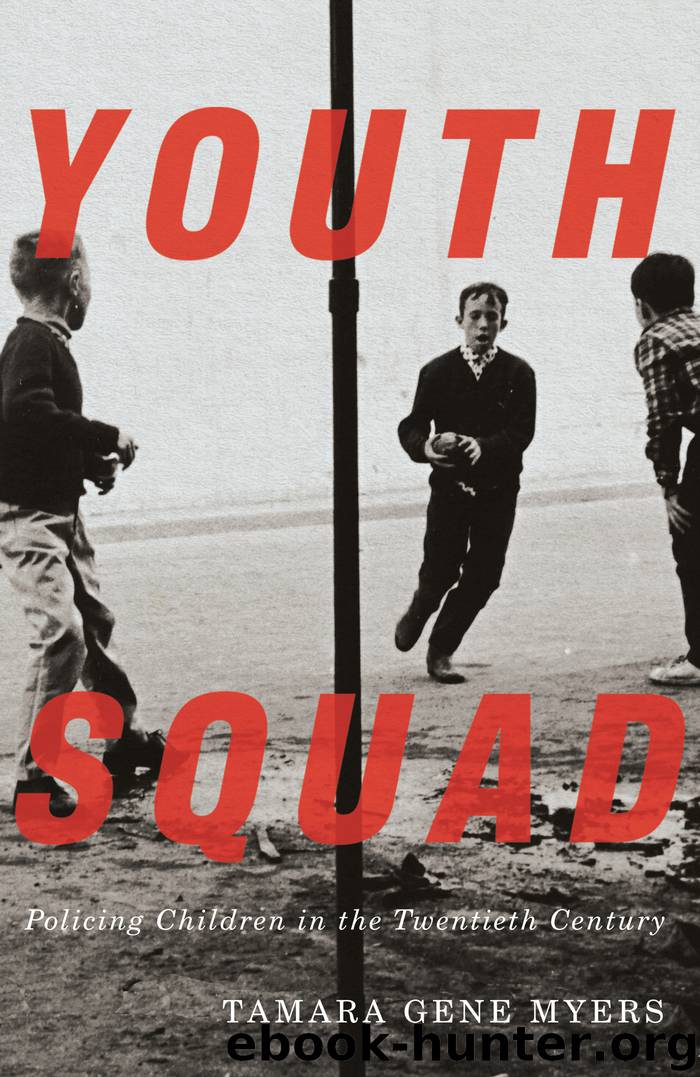Youth Squad by Tamara Gene Myers

Author:Tamara Gene Myers
Language: eng
Format: epub
Publisher: MQUP
Published: 2019-04-14T16:00:00+00:00
4.1 Parc Ovila Pelletier. Photo by author.
Conclusion
Following the Second World War, boys’ “promiscuous shooting” of small-bore rifles presented “a difficult and perplexing problem” for North American communities and especially for police departments. Rifles in the hands of “uninformed and untrained juveniles” amounted to an “extremely dangerous situation,” according to a 1952 report in the Police Chief News. Some jurisdictions were rife with juvenile shooting accidents, including fatalities; yet confiscation was pointless, given the high demand for and ready supply of guns. Such a situation had prompted the Maryland State legislature to present “drastic” firearms bills that, according to Chief of Police Marcus H. Miles of Sparrows Point, Maryland, would be “bad, in that they will forbid all firearms to the public.” 115 Rather than clear the streets of firearms, Police Chief Marcus thought it better to educate youth about proper respect for and handling of weaponry. In collaboration with the local YMCA and Boy Scouts, this local Maryland police department offered rifle instruction at police facilities, employing police as instructors. Rifles and ammunition were secured from the US Army, as were charters for a Junior Club from the National Rifle Association of America. By 1952, the Sparrows Point Police Department ran eight rifle clubs with more than three hundred boys in training. Over the course of the five years of the clubs’ operations, Chief Miles bragged, promiscuous shooting had disappeared, no club boy had been found delinquent, and relations between the police and youth had “never been better.” He pointed to how some youthful graduates demonstrated the connection between club membership, rifle instruction, and citizenship by signing up for the armed services and serving their country.
Predicated on environmentalist ideas, crime prevention programs like PAL and PJC were designed to provide young people with alternatives to unsupervised street play. The PAL system was first and foremost a crime prevention scheme that was directed at incipient criminality and criminals, or young people whose lack of access to “proper” recreation made them vulnerable to anti-social behaviour. The notion that sports and leisure activities could have a remedial effect on latent delinquency held powerful currency in the early twentieth century.
Playing coach to youth was readily accepted as an effective police strategy. A Canadian Police Gazette reporter noted what had become axiomatic in the mid-twentieth century: “Much of the juvenile delinquency problem would be eliminated in most cities if the police officers and the youth … were closer friends.” 116 What better way to become friends? Police-led clubs focusing on skill development, such as rifle shooting, and especially sports and recreational activities became sites for “breaking down barriers between the kids and the police.” Young people and their apparent need for recreational engagement allowed the police to reinvent themselves as central to citizenship campaigns and to counter the negative images polices held surrounding corruption and abuse of power.
Some boys undoubtedly benefited from police efforts to offer them the possibility of learning and playing a sport. Happy, white, sporty youth played well in the media. Boys
Download
This site does not store any files on its server. We only index and link to content provided by other sites. Please contact the content providers to delete copyright contents if any and email us, we'll remove relevant links or contents immediately.
Cecilia; Or, Memoirs of an Heiress — Volume 1 by Fanny Burney(32440)
Cecilia; Or, Memoirs of an Heiress — Volume 2 by Fanny Burney(31875)
Cecilia; Or, Memoirs of an Heiress — Volume 3 by Fanny Burney(31858)
The Great Music City by Andrea Baker(31539)
We're Going to Need More Wine by Gabrielle Union(18973)
All the Missing Girls by Megan Miranda(15599)
Pimp by Iceberg Slim(14399)
Bombshells: Glamour Girls of a Lifetime by Sullivan Steve(13979)
Talking to Strangers by Malcolm Gladwell(13233)
Norse Mythology by Gaiman Neil(13217)
Fifty Shades Freed by E L James(13163)
For the Love of Europe by Rick Steves(13134)
Mindhunter: Inside the FBI's Elite Serial Crime Unit by John E. Douglas & Mark Olshaker(9212)
Crazy Rich Asians by Kevin Kwan(9174)
The Lost Art of Listening by Michael P. Nichols(7412)
Enlightenment Now: The Case for Reason, Science, Humanism, and Progress by Steven Pinker(7242)
The Four Agreements by Don Miguel Ruiz(6641)
Bad Blood by John Carreyrou(6559)
Weapons of Math Destruction by Cathy O'Neil(6152)
